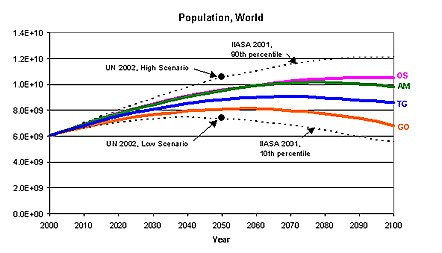Probabilistic Population Projections for the Millennium
Ecosystem Assessment
POP's role in this interdisciplinary effort was to design a number of scenarios for future population change that were consistent with other socio-economic and environmental aspects of the integrated MA scenarios.
This task required the development of a new methodology for defining scenarios based on IIASA's probabilistic population projections. In the Millennium Assessment, uncertainty is not treated probabilistically but rather in the form of a small number of alternative scenarios. This approach is common in analyses with deep uncertainty that are aimed at exploring "if-then" kinds of questions; e.g., if the world adopts a particular style of environmental management, or if it emphasizes a particular type of socio-economic development, what would the consequences be for ecosystems and well-being? Given this approach, individual population scenarios, rather than probability distributions of possible outcomes, were needed. Of course population scenarios are certainly available from other institutions and even from past work at IIASA, but such "off the shelf" scenarios will not necessarily be consistent with the other dimensions of the scenarios developed in the MA such as assumed future socio-economic conditions in different regions of the world. In addition, this approach would not provide an assessment of the uncertainty associated with a given scenario.
The POP project therefore developed an approach based on its work on conditional probabilistic projections. Such projections combine the benefits of the scenario approach (the clear if-then structure) with the benefits of the probabilistic approach (the quantitative characterization of uncertainty). The process of producing the projections consisted of first producing probabilistic projections conditional on the four MA scenarios, which gave a quantitative estimate of the plausible range of population outcomes assuming each of the MA scenarios actually came to pass. Next, single scenarios were defined that were representative of each of the conditional probabilistic projections. These four population projections were then used in the larger MA scenario analysis.
An advantage of this methodology is that it provides population projections that are tailored to the MA scenarios, but that are based on recent, well-known, peer-reviewed projections in a well-defined manner. In addition, it provides a quantitative assessment of the uncertainty associated with the single population projection developed for each MA scenario, since each of the four projections is associated with a conditional probabilistic projection.

MA Scenarios:
- OM, Order from Strength
- AM, Adaptive Mosaic
- TG, Technogarden
- GO, Global orchestration



